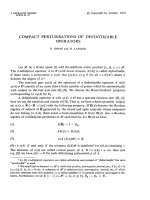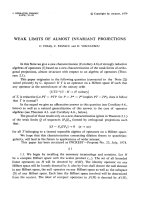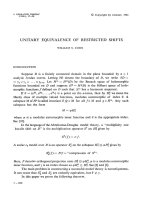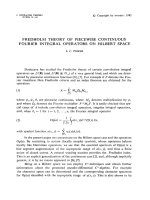Báo cáo toán học: " Efficiency of Embedded Explicit Pseudo Two-Step RKN Methods on a Shared Memory Parallel Computer" ppsx
Bạn đang xem bản rút gọn của tài liệu. Xem và tải ngay bản đầy đủ của tài liệu tại đây (190.31 KB, 14 trang )
Vietnam Journal of Mathematics 34:1 (2006) 95–108
Efficiency of Embedded Explicit
Pseudo Two-Step RKN Methods on a
Shared Memory Parallel Computer
*
N. H. Cong
1
,H.Podhaisky
2
,andR.Weiner
2
1
Faculty of Math., Mech. and Inform., Hanoi University of Science
334 Nguyen Trai, Thanh Xuan, Hanoi, Vietnam
2
FB Mathematik und Informatik, Martin-Luther-Universit¨at Halle-Wittenberg
Theodor-Lieser-Str. 5, D-06120 Halle, Germany
Received June 22, 2005
Abstract. The aim of this paper is to construct two embedded explicit pseudo two-
step RKN methods (embedded EPTRKN methods) of order 6 and 10 for nonstiff initial-
value problems (IVPs)
y
(t)=f(t, y(t)), y(t
0
)=y
0
, y
(t
0
)=y
0
and investigate
their efficiency on parallel computers. For these two embedded EPTRKN methods
and for expensive problems, the parallel implementation on a shared memory parallel
computer gives a good speed-up with respect to the sequential one. Furthermore, for
numerical comparisons, we solve three test problems taken from the literature by the
embedded EPTRKN methods and the efficient nonstiff code ODEX2 running on the
same shared memory parallel computer. Comparing computing times for accuracies
received shows that the two new embedded EPTRKN methods are superior to the code
ODEX2 for all the test problems.
1. Introduction
The arrival of parallel computers influences the development of numerical meth-
ods for a nonstiff initial-value problem (IVP) for systems of special second-order
ordinary differential equations (ODEs)
∗
This work was supported by Vietnam NRPFS and the University of Halle.
96 N. H. Cong, H. Podhaisky, and R. Weiner
y
(t)=f(t, y(t)), y(t
0
)=y
0
, y
(t
0
)=y
0
, y, f ∈ R
d
. (1.1)
The most efficient numerical methods for solving this problem are the explicit
Runge-Kutta-Nystr¨om (RKN) and extrapolation methods. In the literature,
sequential explicit RKN methods up to order 11 can be found in e.g., [16-21,
23, 28]. In order to exploit the facilities of parallel computers, a number of
parallel explicit methods have been investigated, for example in [2-6, 9-14]. A
common challenge in the latter mentioned works is to reduce, for a given order
of accuracy, the required number of effective sequential f -evaluations per step,
using parallel processors.
In previous work of Cong et al. [14], a general class of explicit pseudo two-
step RKN methods (EPTRKN methods) for solving problems of the form (1.1)
has been investigated. These EPTRKN methods are ones of the cheapest parallel
explicit methods in terms of number of effective sequential f-evaluations per step.
They can be easily equipped with embedded formulas for a variable stepsize
implementation (cf. [9]). With respect to the number of effective sequential f-
evaluations for a given accuracy, the EPTRKN methods have been shown to be
much more efficient than most efficient sequential and parallel methods currently
available for solving (1.1) (cf. [9, 14]).
Most numerical comparisons of parallel and sequential methods are done by
means of the number of effective sequential f -evaluations for a given accuracy on
a sequential computer ignoring the communication time between processors (cf.
e.g., 1, 3, 5, 6]). In comparisons of different codes running on parallel computers,
the parallel codes often give disappointing results. However, in our recent work
[15], two parallel codes EPTRK5 and EPTRK8 of oder 5 and 8, respectively,
have been proposed. These codes are based on EPTRK methods considered
in [7, 8] which are a “first-order” version of the EPTRKN methods. The EP-
TRK5 and EPTRK8 codes have been shown to be more efficient than the codes
DOPRI5 and DOP853 for solving expensive nonstiff first-order problems on a
shared memory parallel computer. We have also obtained a similar performance
of a parallel implementation of the BPIRKN codes for nonstiff special second-
order problems (see [13]). These promising results encourage us to pursue the
efficiency investigation of a real implementation of the EPTRKN methods on a
parallel computer. This investigation consists of choosing relatively good embed-
ded EPTRKN methods, defining reasonable error estimate for stepsize strategy
and comparing the resulting EPTRKN methods with the code ODEX2 which is
among the most efficient sequential nonstiff integrators for special second-order
ODE systems of the form (1.1). Differed from the EPTRKN methods consid-
ered in [9], the embedded EPTRKN methods constructed in this paper are based
on collocation vectors which minimise the stage error coefficients and/or satisfy
the orthogonality relation (see Sec. 3.1). In addition to that, their embedded
formulas are also derived by a new way (see Sec. 2.2). Although the class of
EPTRKN methods contains methods of arbitrary high order, we consider only
two EPTRKN methods of order 6 and 10 for numerical comparisons with the
code ODEX2.
We have to note that the choice of an implementation on a shared memory
Efficiency of Embedded Explicit Pseudo Two-Step RKN Methods 97
parallel computer is due to the fact that such a computer can consist of sev-
eral processors sharing a common memory with fast data access requiring less
communication times, which is suited to the features of the EPTRKN methods.
In addition, there are the advantages of compilers which attempt to parallelize
codes automatically by reordering loops and sophisticated scientific libraries (cf.
e.g., [1]).
In order to see a possible speed-up of a parallel code, the test problems used
in Sec. 3 should be expensive. Therefore, the relatively small problems have
been enlarged by scaling.
2. Variable Stepsize Embedded EPTRKN Methods
The EPTRKN methods have been recently introduced and investigated in [9,
14]. For an implementation with stepsize control, we consider variable stepsize
embedded EPTRKN methods. Because EPTRKN methods are of a two-step
nature, there is an additional difficulty in using these methods with variable
stepsize mode. We overcome this difficulty by deriving methods with variable
parameters (cf. e.g., [24, p. 397; 1, p. 44]). Thus, we consider the variable
stepsize EPTRKN method (cf. [9])
Y
n
= e ⊗ y
n
+ h
n
c ⊗ y
n
+ h
2
n
(A
n
⊗ I)F(t
n−1
e + h
n−1
c, Y
n−1
), (2.1a)
y
n+1
= y
n
+ h
n
y
n
+ h
2
n
(b
T
⊗ I)F(t
n
e + h
n
c, Y
n
),
y
n+1
= y
n
+ h
n
(d
T
⊗ I)F(t
n
e + h
n
c, Y
n
), (2.1b)
with variable stepsize h
n
= t
n+1
− t
n
and variable parameter matrix A
n
.This
EPTRKN method is conveniently specified by the following tableau:
A
n
c O
0
T
y
n+1
b
T
0
T
y
n+1
d
T
At each step, 2s f -evaluations of the components of the big vectors F(t
n−1
e +
h
n−1
c, Y
n−1
)=(f(t
n−1
+ c
i
h
n−1
, Y
n−1,i
)) and F(t
n
e + h
n
c, Y
n
)=(f(t
n
+
c
i
h
n
, Y
n,i
)), i =1, ,s areusedinthemethod. However,s f-evaluations
of the components of F(t
n−1
e + h
n−1
c, Y
n−1
) are already available from the
preceding step. Hence, we need to compute only s f -evaluations of the compo-
nents of F(t
n
e + h
n
c, Y
n
), which can be done in parallel. Consequently, on an
s-processor computer, just one f-evaluation is required per step. In this way,
parallelization in an EPTRKN method is achieved by sharing the f-evaluations
of s components of the big vector F(t
n
e + h
n
c, Y
n
) over a number of available
processors. An additional computational effort consists of a recomputation of
the variable parameter matrix A
n
defined by (2.2e) below when the stepsize is
changed.
2.1. Method Parameters
98 N. H. Cong, H. Podhaisky, and R. Weiner
The matrix A
n
and the weight vectors b
T
and d
T
of the method (2.1) are derived
by the order conditions (see [9, 14])
τ
j−1
n
c
j+1
j +1
− A
n
j(c − e)
j+1
= 0,j=1, ,q, (2.2a)
1
j +1
− b
T
jc
j−1
=0,j=1, ,p, (2.2b)
1
j
− d
T
c
j−1
=0,j=1, ,p, (2.2c)
where τ
n
= h
n
/h
n−1
is the stepsize ratio. Notice that the conditions (2.2b),
(2.2c) for p = s define the weight vectors of a direct collocation-based IRKN
method (cf. [26]).
For q = p = s, by defining the matrices and vectors
P =
c
j+1
i
j +1
,Q=
j(c
i
− 1)
j−1
,R=
jc
j−1
i
,S=
c
j−1
i
,
D
n
=diag(1,τ
n
, ,τ
s−1
n
), v =
1
j
, w =
1
j +1
,i,j=1, ,s,
the conditions (2.2) can be written in the form
A
n
Q − PD
n
= O, w
T
− b
T
R = 0
T
, v
T
− d
T
S = 0
T
, (2.2d)
which implies the explicit formulas for the parameters of a EPTRKN method
A
n
= PD
n
Q
−1
, b
T
= w
T
R
−1
, d
T
= v
T
S
−1
. (2.2e)
For determining the order of EPTRKN methods constructed in Sec. 3.1, we need
the following theorem, which is similar to Theorem 2.1 in [9].
Theorem 2.1. If the step ratio τ
n
is bounded from above (i.e., τ
n
Ω) and
if function f is Lipschitz continuous, the s-stage EPTRKN metho d (2.1) with
pa rameter matrix and vectors A
n
, b, d defined by (2.2e) is of stage ord er q = s
and ord er p = s for any collocation vector c with distinct abscissae c
i
. It has
higher stage order q = s +1 and order p = s +1or p = s +2 if in addition the
orthogonality relation
P
j
(1) = 0,P
j
(x):=
x
0
ξ
j−1
s
i=1
(ξ −c
i
)dξ, j =1, ,k,
holds for k =1or k 2, respectively.
The proof of this theorem follows the same line as in the proof of a very
similar theorem formulated in [9, proof of Theorem 2.1].
2.2. Embedded Formulas
Efficiency of Embedded Explicit Pseudo Two-Step RKN Methods 99
With the aim to have a cheap error estimate used in the stepsize selection for
an implementation of EPTRKN methods with stepsize control, we shall equip
the pth-order EPTRKN method (2.1) with the following embedded formula
y
n+1
=y
n
+ h
n
y
n
+ h
2
n
(
b
T
⊗ I)F(t
n
e + h
n
c, Y
n
),
y
n+1
=y
n
+ h
n
(
d
T
⊗ I)F(t
n
e + h
n
c, Y
n
),
(2.3)
where, the weight vectors
b and
d are determined by satisfying the following
conditions which come from (2.2b) and (2.2c)
1
j +1
−
b
T
jc
j−1
=0,j=1, ,s−2,
1
s
−
b
T
(s − 1)c
s−2
=0, (2.4a)
1
j
−
d
T
c
j−1
=0,j=1, ,s− 1,
1
s
−
d
T
c
s−1
=0. (2.4b)
In the two EPTRKN codes considered in this paper, we use these embedded
weight vectors defined as
b
T
=
w
T
−
1
10
e
T
s−1
R
−1
,
d
T
=
v
T
−
1
10
e
T
s
S
−1
, (2.5)
where e
T
s
=(0, ,0, 1) and e
T
s−1
=(0, ,1, 0) are the s-th and (s −1)-th unit
vectors. It can be seen that the following simple theorem holds
Theorem 2.2. The embedded formula defined by (2.3) and (2.5) is of order s−1
for any collo cation vector c with distinct abscissae c
i
.
In this way we have an estimate for the local error of order p = s−1 without
additional f -evaluations given by
y
n+1
−
y
n+1
= O(h
p+1
n
), y
n+1
−
y
n+1
= O(h
p+1
n
). (2.6)
Thus, we have defined the embedded EPTRKN method of orders p(p)givenby
(2.1), (2.2e), (2.3) and (2.5) which can be specified by the tableau
A
n
c O
0
T
y
n+1
b
T
0
T
y
n+1
d
T
0
T
y
n+1
b
T
0
T
y
n+1
d
T
Finally, we have to note that the approach used in the derivation of the em-
bedded formula above is different from the one used in [8, 9, 13, 15]. By this
approach of constructing embedded EPTRKN methods, there exist several em-
bedded formulas for an EPTRKN method.
2.3. Stability Properties
100 N. H. Cong, H. Podhaisky, and R. Weiner
Stability of (constant stepsize) EPTRKN methods was investigated by applying
them to the model test equation y
(t)=λy(t), where λ runs through the eigen-
values of the Jacobian matrix ∂f/∂y which are assumed to be negative real. It
is characterized by the spectral radius ρ(M(x)), x = λh
2
,ofthe(s +2)×(s +2)
amplification matrix M (x) defined by (cf. [14, Sec. 2.2])
M(z)=
⎛
⎝
xA ec
x
2
b
T
A 1+xb
T
e 1+xb
T
c
x
2
d
T
Axd
T
e 1+xd
T
c
⎞
⎠
. (2.7a)
The stability interval of an EPTRKN method is given as
(−β
stab
, 0) := {x : ρ(M(x)) 1}. (2.7b)
The stability intervals of the EPTRKN methods used in our numerical codes
can be found in Sec. 3.
3. Numerical Experiments
In this section we shall report the numerical results obtained by the sequential
code ODEX2 and two our new parallel EPTRKN codes for comparing their
efficiency.
3.1. Specifications of the Codes
ODEX2 is an extrapolation code for special second-order ODEs of the form (1.1).
It uses variable order and stepsize and is implemented in the same way as the
ODEX code for first-order ODEs (cf. [24, p. 294, 298]). This code is recognized
as being one of the most efficient sequential integrators for nonstiff problems like
(1.1) (see [24, p. 484]). In the numerical experiments, we apply ODEX2 code
with standard parameter settings.
Our first code uses a variable stepsize embedded EPTRKN method based on
collocation vector c =(c
1
,c
2
,c
3
, 1)
T
which satisfies the relations
1
0
x
j−1
4
i=1
(x − c
i
)dx =0,j=1, 2 (3.1a)
(b
T
+ d
T
)
c
s+2
s +2
− A(s +1)(c − e)
s
=0, (3.1b)
where (3.1a) is an orthogonality relation (cf. [24, p. 212]), and (3.1b) is in-
troduced for minimizing the stage error coefficients (cf. [29]). The resulting
method is of step point order 6 and stage order 5 (see Theorem 2.1). It has 4 as
the optimal number of processors, and an embedded formula of order 3 (see The-
orem 2.2). Its stability interval as defined in Sec. 2.3 is determined by numerical
search techniques to be (−0.720, 0). This first code is denoted by EPTRKN4.
Our second code uses a variable stepsize embedded EPTRKN method based
on collocation vector c =(c
1
, ,c
8
)
T
which is obtained by solving the system
of equations
Efficiency of Embedded Explicit Pseudo Two-Step RKN Methods 101
1
0
x
j−1
8
i=1
(x − c
i
)dx =0,j=1, 2, 3, (3.2a)
c
4
=1,c
4+k
=1+c
k
,k=1, 2, 3, 4. (3.2b)
Here (3.2a) is again an orthogonality relation. The resulting method is of step
point order 10 and stage order 9 (see also Theorem 2.1). It has 8 as the optimal
number of processors, and an embedded formula of order 7 (see also Theorem
2.2). Its stability interval is also determined by the numerical search techniques
to be (−0.598, 0). This second code is denoted by EPTRKN8.
Table 1 summarizes the main characteristics of the codes: the step point
order p, the embedded order p, the optimal number of processors np and the
stability interval (−β
stab
, 0).
Table 1. EPTRKN codes used in the numerical experiments
Code names p ˆpnp(−β
stab
, 0)
EPTRKN4 6 3 4 (−0.720, 0)
EPTRKN8 10 7 8 (−0.598, 0)
Both codes EPTRKN4 and EPTRKN8 are implemented using local extrapola-
tion and direct PIRKN methods based on the same collocation points (cf. [3]) as
a starting procedure. The local error of order p denoted by LERR is estimated
as
LERR =
1
d
d
i=1
y
n+1,i
− y
n+1,i
AT OL + RT OL|y
n+1,i
|
2
+
y
n+1,i
− y
n+1,i
AT OL + RT OL|y
n+1,i
|
2
.
The new stepsize h
n+1
is chosen as
h
n+1
= h
n
· min
2, max
0.5, 0.85 · LERR
−1/(p+1)
. (3.3)
The constants 2 and 0.5 serve to keep the stepsize ratios τ
n+1
= h
n+1
/h
n
to be
in the interval
0.5, 2
.
The computations were performed on a HP-Convex X-Class Computer. The
parallel codes EPTRKN4 and EPTRKN8 were implemented in sequential and
parallel modes. They can be downloaded from -
halle.de/institute/numerik/software.
3.2. Numerical Comparisons
The numerical comparisons in this section are mainly made in terms of com-
puting time for an accuracy received. However, since the parameters of the two
102 N. H. Cong, H. Podhaisky, and R. Weiner
EPTRKN methods used in this paper are new, we would like to test the perfor-
mance of these methods by comparing the number of f-evaluations for a given
accuracy.
Test Pro blem s
For comparing the number of f-evaluations, we take two very well-known small
test problems from the RKN literature:
FEHL - the nonlinear Fehlberg problem (cf. e.g., [16, 17, 19, 20])
d
2
y(t)
dt
2
=
−4t
2
−
2
√
y
2
1
(t)+y
2
2
(t)
2
√
y
2
1
(t)+y
2
2
(t)
−4t
2
y(t),
y(
π/2) = (0, 1)
T
, y
(
π/2) = (−2
π/2, 0)
T
π/2 t 10,
with highly oscillating exact solution given by y(t)=(cos(t
2
), sin(t
2
))
T
.
NEWT - the two-body gravitational problem for Newton’s equation of motion
(see e.g., [30, p. 245], [27, 20])
d
2
y
1
(t)
dt
2
= −
y
1
(t)
y
2
1
(t)+y
2
2
(t)
3
,
d
2
y
2
(t)
dt
2
= −
y
2
(t)
y
2
1
(t)+y
2
2
(t)
3
,
y
1
(0) = 1 − ε, y
2
(0) = 0,y
1
(0) = 0,y
2
(0) =
1+ε
1 − ε
, 0 t 20.
The solution components are y
1
(t)=cos(u(t))−ε, y
2
(t)=
(1 + ε)(1 − ε)sin(u(t)),
where u(t) is the solution of Kepler’s equation t = u(t)−ε sin(u(t)) and ε denotes
the eccentricity of the orbit. In this example, we set ε =0.9.
For comparing the computing time, we take the following three “expensive”
problems:
PLEI - the celestial mechanics problem from [24] which models the gravity
forces between seven stars in 2D space. This modelling leads to a second-order
ODE system of dimension 14. Because this system is too small, it is enlarged
by a scaling factor ns = 500 to become the new one
e ⊗ y
(t)=e ⊗ f (t, y(t)), e ∈ R
ns
.
MOON - the second celestial mechanics example which is formulated in a similar
way for 101 bodies in 2D space with coordinates x
i
,y
i
and masses m
i
(i =
0, ,100)
x
i
= γ
100
j=0,j =i
m
j
(x
j
− x
i
)/r
3
ij
,y
i
= γ
100
j=0,j =i
m
j
(y
j
− y
i
)/r
3
ij
,
where
r
ij
=((x
i
− x
j
)
2
+(y
i
− y
j
)
2
)
1/2
,i,j=0, ,100
γ =6.672,m
0
=60,m
i
=7·10
−3
,i=1, ,100.
Efficiency of Embedded Explicit Pseudo Two-Step RKN Methods 103
We integrate for 0 t 125 with the initial data
x
0
(0) = y
0
(0) = x
0
(0) = y
0
(0) = 0
x
i
(0) = 30 cos(2π/100i) + 400,x
i
(0) = 0.8sin(2π/100i)
y
i
(0) = 30 sin(2π/100i),y
i
(0) = −0.8cos(2π/100i)+1.
Here no scaling was needed because the right-hand side functions are very ex-
pensive.
WAV E - the semidiscretized problem for 1D hyperbolic equations (see [25]).
∂
2
u
∂t
2
= gd(x)
∂
2
u
∂x
2
+
1
4
λ
2
(x, u), 0 x b, 0 t 10,
∂u
∂x
(t, 0) =
∂u
∂x
(t, b)=0,
u(0,t)=sin
πx
b
,
∂u
∂t
(0,x)=−
π
b
cos
πx
b
with
d(x)=10
2+cos
2πx
b
,λ=
4 · 10
−4
g|u|
d(x)
,g=9.81,b= 1000.
By using second-order central spatial discretization on a uniform grid with 40
inner points we obtain a nonstiff ODE system. In order to make this problem
more expensive, we enlarge it by a scaling factor ns = 100.
Results and Discussion
The three codes ODEX2, EPTRKN4 and EPTRKN8 were applied to the above
test problems with AT OL = RT OL =10
−1
, 10
−2
, ,10
−11
, 10
−12
.Thenum-
ber of sequential f-evaluations (for FEHL and NEWT problems) and the com-
puting time (for PLEI, MOON and WAV E problems) are plotted as a function
of the global error ERR at the end point of the integration interval defined by
ERR =
1
d
d
i=1
y
n+1,i
− y(t
n+1
)
i
AT OL + RT OL|y(t
n+1
)
i
|
2
.
For problems PLEI, MOON and WAV E without exact solutions in a closed
form, we use the reference solution obtained by ODEX2 using AT OL = RT OL =
10
−14
.
For problems FEHL and NEWT wherewecomparethenumberoff-
evaluations for a given accuracy, the results in Fig. 1 – 2 show that on a sequen-
tial implementation mode (symbols associated with ODEX2, EPTRKN4 and
EPTRKN8) the three codes are comparable. But on a parallel implementation
mode, the two parallel codes EPTRKN4 and EPTRKN8 using the optimal num-
ber of processors 4 and 8, respectively (symbols associated with EPTRKN4(4)
and EPTRKN8(8)) are by far superior to ODEX2, and the code EPTRKN8 is
the most efficient.
104 N. H. Cong, H. Podhaisky, and R. Weiner
Fig. 1. Results for FEHL
Fig. 2. Results for NEWT
Fig. 3. Results for PLEI
Efficiency of Embedded Explicit Pseudo Two-Step RKN Methods 105
For PLEI, MOON and WAV E problems where we compare the computing
time, the results plotted in Fig. 3 – 5 show that for PLEI and WAV E problems,
the two EPTRKN codes are competitive with or even more efficient than ODEX2
in the sequential implementation mode. But the parallelized EPTRKN4 and
EPTRKN8 codes are again superior to ODEX2, and the results for EPTRKN4
and EPTRKN8 are almost comparable.
Fig. 4. Results for WAV E
Fig. 5. Results for MOON
For MOON, EPTRKN4 is again competitive with ODEX2 in the sequential
implementation mode. Compared with ODEX2, the parallelized EPTRKN4 and
EPTRKN8 show the same efficiency as for the problems PLEI and WAV E .
The parallel speedup (cf. e.g., [13]) with AT OL = RT OL =10
−8
as shown
in Fig. 6, is very problem dependent. Using the optimal number of processors,
the best speedup obtained by the codes EPTRKN4 and EPTRKN8 for the
106 N. H. Cong, H. Podhaisky, and R. Weiner
problem MOON is approximately 3.3 and 5.5, respectively. We can also see
from the results in Fig. 3 – 5 that for more stringent tolerances, a better speedup
can be achieved.
Fig. 6. parallel speedup
4. Concluding Remarks
In this paper we have considered the efficiency of a class of parallel explicit pseudo
two-step RKN methods (EPTRKN methods) by comparing two new codes from
this class EPTRKN4 and EPTRKN8 with the highly efficient sequential code
ODEX2. By using nonstiff, expensive problems and by implementing these codes
on a shared memory computer, we have shown the superiority of the new parallel
codes over ODEX2. In the future we shall further improve these new parallel
codes by some optimal choices of method parameters.
References
1. K. Burrage, Parallel and Sequential Methods for Ordinary Differential Equations,
Clarendon Press, Oxford, 1995.
2. N. H. Cong, An improvement for parallel-iterated Runge-Kutta-Nystr¨om meth-
ods, Acta Math. Vietnam. 18 (1993) 295–308.
3. N. H. Cong, Note on the performance of direct and indirect Runge-Kutta-Nystr¨om
methods, J. Comput. Appl. Math. 45 (1993) 347–355.
4. N. H. Cong, Direct collocation-based two-step Runge-Kutta-Nystr¨om methods,
SEA Bull. Math. 19 (1995) 49–58.
5. N. H. Cong, Explicit symmetric Runge-Kutta-Nystr¨om methods for parallel com-
puters, Comput. Math. Appl. 31 (1996) 111–122.
6. N. H. Cong, Explicit parallel two-step Runge-Kutta-Nystr¨om methods, Comput.
Math. Appl. 32 (1996) 119–130.
7. N. H. Cong, Explicit pseudo two-step Runge-Kutta methods for parallel comput-
Efficiency of Embedded Explicit Pseudo Two-Step RKN Methods 107
ers, Int. J. Comput. Math. 73 (1999) 77–91.
8. N. H. Cong, Continuous variable stepsize explicit pseudo two-step RK methods,
J. Comput. Appl. Math. 101 (1999) 105–116.
9. N. H. Cong, Explicit pseudo two-step RKN methods with stepsize control, Appl.
Numer. Math. 38 (2001) 135–144.
10. N. H. Cong and N. T. Hong Minh, Parallel block PC methods with RKN-type
correctors and Adams-type predictors, Int. J. Comput. Math. 74 (2000) 509–
527.
11. N. H. Cong and N. T. Hong Minh, Fast convergence PIRKN-type PC methods
with Adams-type predictors, Int. J. Comput. 77 (2001) 373–387.
12. N. H. Cong and N. T. Hong Minh, Parallel-iterated pseudo two-step RKN meth-
ods for nonstiff second-order IVPs, Comput. Math. Appl. 44 (2002) 143–155.
13. N. H. Cong, K. Strehmel, R. Weiner, and H. Podhaisky, Runge-Kutta-Nystr¨om-
type parallel block predictor-corrector methods, Adv. Comput. Math. 38 (1999)
17–30.
14. N. H. Cong, K. Strehmel, and R. Weiner, A general class of explicit pseudo two-
step RKN methods on parallel computers, Comput. Math. Appl. 38 (1999)
17–30.
15. N. H. Cong, H. Podhaisky, and R. Weiner, Numerical experiments with some
explicit pseudo two-step RK methods on a shared memory computer, Comput.
Math. Appl. 36 (1998) 107–116.
16. E. Fehlberg, Klassische Runge-Kutta-Nystr¨om-Formeln mit Schrittweitenkon-
trolle f¨ur Differentialgleichungen
x
= f(t, x),Computing 10 (1972) 305–315.
17. E. Fehlberg, Eine Runge-Kutta-Nystr¨om-Formel 9-ter Ordnung mit Schrittweit-
enkontrolle f¨ur Differentialgleichungen
x
= f(t, x), Z. Angew. Math. Mech. 61
(1981) 477–485.
18. E. Fehlberg, S. Filippi, and J. Gr¨af, Ein Runge-Kutta-Nystr¨om-Formelpaar der
Ordnung 10(11) f¨ur Differentialgleichungen
y
= f(t, y), Z. Angew. Math.
Mech. 66 (1986) 265–270.
19. S. Filippi and J. Gr¨af, Ein Runge-Kutta-Nystr¨om-Formelpaar der Ordnung 11(12)
f¨ur Differentialgleichungen der Form
y
= f(t, y), Computing 34 (1985) 271–282.
20. S. Filippi and J. Gr¨af, New Runge-Kutta-Nystr¨om formula-pairs of order 8(7),
9(8), 10(9) and 11(10) for differential equations of the form
y
= f(t, y), J.
Comput. Appl. Math. 14 (1986) 361–370.
21. E. Hairer, M´ethodes de Nystr¨om pour l’´equations diff´erentielles
y
(t)=f(t, y),
Numer. Math. 27 (1977) 283–300.
22. E. Hairer, Unconditionally stable methods for second order differential equations,
Numer. Math. 32 (1979) 373–379.
23. E. Hairer, A one-step method of order 10 for
y
(t)=f(t, y), IMA J. Numer.
Anal. 2 (1982) 83–94.
24. E. Hairer, S. P. Nørsett and G. Wanner, Solving Ordinary Differential Equations,
I. Nonstiff Problems,2
nd
Edition, Springer-Verlag, Berlin, 1993.
25. P. J. van der Houwen and B. P. Sommeijer, Explicit Runge-Kutta- (Nystr¨om)
methods with reduced phase error for computing oscillating solutions, SIAM J.
Numer. Anal. 24 (1987) 595–617.
108 N. H. Cong, H. Podhaisky, and R. Weiner
26. P. J. van der Houwen, B. P. Sommeijer, and N. H. Cong, Stability of collocation-
based Runge-Kutta-Nystr¨om methods,BIT31 (1991) 469–481.
27. T. E. Hull, W. H. Enright, B. M. Fellen, and A. E. Sedgwick, Comparing numerical
methods for ordinary differential equations, SIAM J. Numer. Anal. 9 (1972)
603–637.
28. E. J. Nystr¨om,
¨
Uber die numerische Integration von Differentialgleichungen, Acta
Soc. Sci. Fenn. 50 (1925) 1–54.
29. H. Podhaisky, R. Weiner, and J. Wensch, High order explicit two-step Runge-
Kutta methods for parallel computers,CIT8 (2000) 13–18.
30. L. F. Shampine and M. K. Gordon, Computer Solution of Ordinary Differential
Equations, The Initial Value Problems, W.H. Freeman and Company, San Fran-
cisco, 1975.
31. B. P. Sommeijer, Explicit, high-order Runge-Kutta-Nystr¨om methods for parallel
computers, Appl. Numer. Math. 13 (1993) 221–240.









